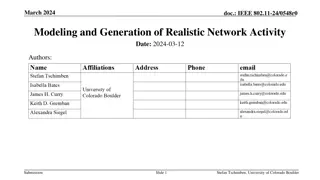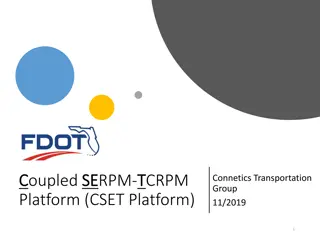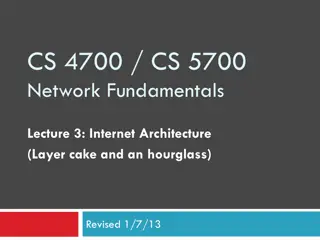Understanding Network Types and Criteria
Distinguishing between Local Area Networks (LAN) and Wide Area Networks (WAN) based on size, geographical coverage, and ownership. LAN connects hosts within a limited area, while WAN spans larger geographical regions. LANs typically privately owned by organizations, while WANs are operated by communication companies. Various examples of WANs, including point-to-point and switched networks, are explored.
Download Presentation

Please find below an Image/Link to download the presentation.
The content on the website is provided AS IS for your information and personal use only. It may not be sold, licensed, or shared on other websites without obtaining consent from the author.If you encounter any issues during the download, it is possible that the publisher has removed the file from their server.
You are allowed to download the files provided on this website for personal or commercial use, subject to the condition that they are used lawfully. All files are the property of their respective owners.
The content on the website is provided AS IS for your information and personal use only. It may not be sold, licensed, or shared on other websites without obtaining consent from the author.
E N D
Presentation Transcript
Network Types The criteria for distinguishing one type of network from another is difficult and sometimes confusing. We use a few criteria such as size, geographical coverage, and ownership to make this distinction. 1. Local Area Network A local area network (LAN) usually connects some hosts in a single office, building, or campus. Depending on the needs of an organization, a LAN can be as simple as two PCs and a printer in someone s home office, or it can extend throughout a company and include audio and video devices. Each host in a LAN has an identifier, an address, that uniquely defines the host in the LAN. A packet sent by a host to another host carries both the source host s and the destination host s addresses.
In the past, all hosts in a network were connected through a common cable, which meant that a packet sent from one host to another was received by all hosts. The intended recipient kept the packet; the others dropped the packet. Today, most LANs use a smart connecting switch, which is able to recognize the destination address of the packet and guide the packet to its destination without sending it to all other hosts. The switch alleviates the traffic in the LAN and allows more than one pair to communicate with each other at the same time if there is no common source and destination among them. Note that the above definition of a LAN does not define the minimum or maximum number of hosts in a LAN. Figure 1 shows a LAN using either a common cable or a switch.
2.Wide Area Network A wide area network (WAN) is also an interconnection of devices capable of communication. However, there are some differences between a LAN and a WAN. A LAN is normally limited in size, spanning an office, a building, or a campus; a WAN has a wider geographical span, spanning a town, a state, a country, or even the world. A LAN interconnects hosts; a WAN interconnects connecting devices such as switches, routers, or modems. A LAN is normally privately owned by the organization that uses it; a WAN is normally created and run by communication companies and leased by an organization that uses it.
two distinct examples of WANs: A- point-to-point WANs: A point-to-point WAN is a network that connects two communicating devices through a transmission media (cable or air). Figure 2 shows an example of a point-to-point WAN. Figure 2 A point-to-point WAN
B- Switched WANs: A switched WAN is a network with more than two ends. A switched WAN is used in the backbone of global communication today. We can say that a switched WAN is a combination of several point-to-point WANs that are connected by switches. Figure 3 shows an example of a switched WAN. Figure 3 A switched WAN
Internetwork Today, it is very rare to see a LAN or a WAN in isolation; they are connected to one another. When two or more networks are connected, they make an internetwork or internet. As an example, assume that an organization has two offices, each one in a different country. Each office has a LAN that allows all employees in the office to communicate with each other. To make communication between employees at different offices possible, the management leases a point-to-point dedicated WAN from a service provider, such as a telephone company, and connects the two LANs. Now the company has internetwork or a private internet. Communication between offices is now possible. Figure 4 shows this internet. Figure 4 An internetwork made of two LANs and one point-to-point WAN
3. The Internet As we discussed before, the internet (note the lowercase i) is two or more networks that can communicate with each other, is composed of thousands of interconnected networks. Figure 5 shows a conceptual view of the Internet. The figure shows the Internet as several backbones, provider networks, and customer networks. At the top level, the backbones are large networks owned by some communication companies such as Sprint, Verizon (MCI), AT&T, and NTT. The backbone networks are connected through some complex switching systems, called peering points. At the second level, there are smaller networks, called provider networks, that use the services of the backbones for a fee. The provider networks are connected to backbones and sometimes to other provider networks. The customer networks are networks at the edge of the Internet that actually use the services provided by the Internet. They pay fees to provider networks for receiving services. Backbones and provider networks are also called Internet Service Providers (ISPs) . The backbones are often referred to as international ISPs; the provider networks are often referred to as national or regional ISPs.
Accessing the Internet The Internet today is an internetwork that allows any user to become part of it. The user, however, needs to be physically connected to an ISP. The physical connection is normally done through a point-to-point WAN. 1-Using Telephone Networks Today most residences and small businesses have telephone service, which means they are connected to a telephone network. Since most telephone networks have already connected themselves to the Internet, one option for residences and small businesses to connect to the Internet is to change the voice line between the residence or business and the telephone center to a point-to-point WAN. This can be done in two ways. AN.
A-Dial-up service. The first solution is to add to the telephone line a modem that converts data to voice. The software installed on the computer dials the ISP and imitates making a telephone connection. Unfortunately, the dial-up service is very slow, and when the line is used for an Internet connection, it cannot be used for a telephone (voice) connection. B-DSL(Digital Subscriber Line)Service. Since the advent of the Internet, some telephone companies have upgraded their telephone lines to provide higher-speed Internet services to residences or small businesses. The DSL service also allows the line to be used simultaneously for voice and data communication.
2-Using Cable Networks More and more residents over the last two decades have begun using cable TV services instead of antennas to receive TV broadcasting. The cable companies have been upgrading their cable networks and connecting to the Internet. A residence or a small business can be connected to the Internet by using this service. It provides a higher speed connection, but the speed varies depending on the number of neighbors that use the same cable. 3-Using Wireless Networks Wireless connectivity has recently become increasingly popular. A household or a small business can use a combination of wireless and wired connections to access the Internet. With the growing wireless WAN access, a household or a small business can be connected to the Internet through a wireless WAN.
4-Direct Connection to the Internet A large organization or a large corporation can itself become a local ISP and be connected to the Internet. This can be done if the organization or the corporation leases a high-speed WAN from a carrier provider and connects itself to a regional ISP. For example, a large university with several campuses can create an internetwork and then connect the internetwork to the Internet.























